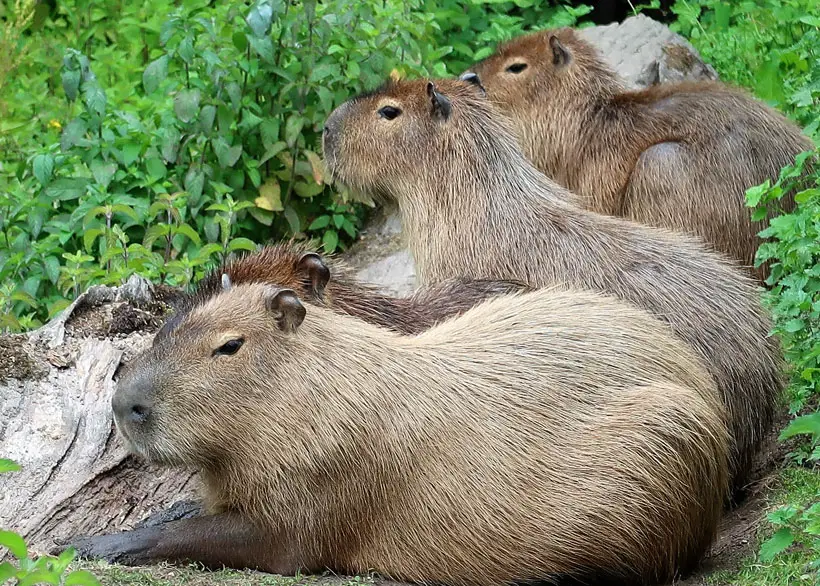Capybara Predators: Animals That Hunt These Giant Rodents
Capybaras are the largest rodents in the Caviidae family, enjoying a dominant position in the animal kingdom. However, it’s interesting to note that they face threats from other animals that prey on them.
So, what are capybaras’ predators? Capybaras’ greatest threats are jaguars, canids, ocelots, and the green anaconda. However, as these wild cats disappear, man has become the current threat to capybaras’ existence. Humans hunt these animals for their meat rich in protein.
We shall review the major animals that hunt these giant rodents and how capybaras defend themselves from predators to survive. We shall also discuss the measures taken by conservation institutions to protect these giant rodents.
Capybara Predators: Animals That Hunt These Giant Rodents
Capybaras are semi-aquatic rodents, meaning they live both on land and in water. Therefore, despite their large body size, they are constantly attacked by even humans.

Let’s look at the main predators of these giant rodents.
Jaguars
Jaguars are the third-largest wild cats in the world with great hunting skills, which leaves slim chances for the capybaras. Jaguars have the following advantages against capybaras.
- Strong night vision makes it easier to hunt capybaras as they feed at night
- They are fast beating the 35km/h of capybaras
- They have spotted skin, helping them camouflage when hunting
- Jaguars are great swimmers with a higher speed than capybaras
- They are predominant in the South American rainforests
Check out this video of a jaguar hunting capybara.
Ocelots
Ocelots are members of the wild cat family with high hunting skills. They are opportunistic animals attacking capybaras when resting and are less active at the river banks.
These species are smaller than jaguars but have great swimming, climbing, and running skills making it hard for the capybara to escape. Their skin has stripes for camouflaging with the grass environment.
They target the neck to kill and immobilize their prey carrying it to a safe place to eat.

Crab-Eating Fox
Crab-eating fox feed on small animals such as crabs and crayfish. However, without these small animals, they hunt for young capybaras, which are easier to kill.
These foxes are found in the thick rainforest of South America and hunt in groups to increase their hunting power. They use claws to kill prey and drag them into hiding places to eat later.

Alligators
Alligators are among the most dangerous water predators, as they can feed on a whole capybara. They have sharp teeth arranged in sequential order, helping them grab prey and tear it with ease.
Alligators, unlike caimans, are large and hence stronger, making it easy to eat even the largest capybara. They wait for capybaras at river banks and attack with their sharp teeth.

Humans
Human beings are known to hunt capybaras for their protein-rich meat skins for natural leather.
Man has become capybaras’ main predator, especially in South America, since they use advanced technology to hunt them. Human beings keep capybaras in their homes and zoos for meat. Their tender meat is one of the greatest delicacies in the South American region.
Green Anaconda
Native to the South American rainforests and near water bodies in the thick savanna. Green anacondas are one of the major predators and feed on capybaras at night when they are less active or asleep.
Their huge bodies, almost 30 feet long, help them attack almost any size of prey. Green anacondas camouflage with the green grass and attack the unnoticing capybaras when grazing or in water.
They kill using their venomous bites and by squeezing their prey to suffocation.

Caimans
Caimans are from the alligator family and are well-adapted to hunt capybaras with minimal chances of survival.
They live in and around water bodies awaiting capybaras to come swimming. These animals have sharp saw-like teeth and strong jaws for gripping and tearing their prey into pieces.
How Does The Capybara Defend Itself From Predators
Capybaras have no well-developed physical defending features. However, they are equipped with the following adaptive responses towards danger and physical features.
- Strong short legs with webbed feet for fast swimming while in water bodies.
- The short legs enable them to run as fast as 35 km/h away from enemies.
- They can fully immerse themselves in water for up to five minutes to evade predators.
- They communicate with each other when in danger by barking, purring, and squealing.

Conservation Measures To Protect Capybaras From Extinction
Capybaras are least concerned, according to the IUCN listing but need protection to avoid getting them extinct. Below are conservation measures aimed at protecting these giant rodents.
- Establishment of zoos to keep and reproduce these animals with proper care and protection
- Allowing for controlled pet keeping of capybaras in the United States. This allows the protection of capybaras while in captive
- Restoration and reclamation of their natural habitats in the South American rainforests.
- Establishment of health care centers for capybaras keepers to take their animals for check-ups.

FAQs
Below are some frequently asked questions about capybaras’ predation.
Q: What Is The Lifespan Of Capybaras?
In captivity, capybaras’ lifespan is between 10-15 years with proper care and protection. However, in the wild, their lifespan is reduced to around four years due to constant habitat loss and predation from other wild animals.
Q: Do Capybaras Get Along With All Animals?
No. Capybaras do not get along with all animals. They face threats from animals such as wild dogs, jaguars, and the green anaconda. However, they are seen to get along with some wild animals, such as crocodiles and caimans. Below is a video of capybara chilling with caimans.
They are often seen on river banks relaxing together. Their existence is unique, as many other aquatic mammals eat capybaras for food.
Q: Do Capybaras Eat Other Animals?
Capybaras are herbivorous animals and feed on grass, tree barks, and water plants in the wild rainforests. They are great grazers with well-adapted canines that continuously grow due to wear when feeding.
However, they are seen to feed on insects and small frogs when in captivity to supplement their main diet.
Conclusion
Capybaras’ main threats are semi-aquatic animals such as alligators, green anacondas, and caimans that can swim faster than capybaras. They are also predated by wild cats such as jaguars, crab-eating foxes, and ocelots. Humans are also their main predators for meat and hide.
To survive in these environments, capybaras have great swimming skills and hide in water by immersing themselves underwater for up to five minutes. They also have a high reproductivity capacity giving birth to litters of up to 8 pups to compensate for the lost flocks.




